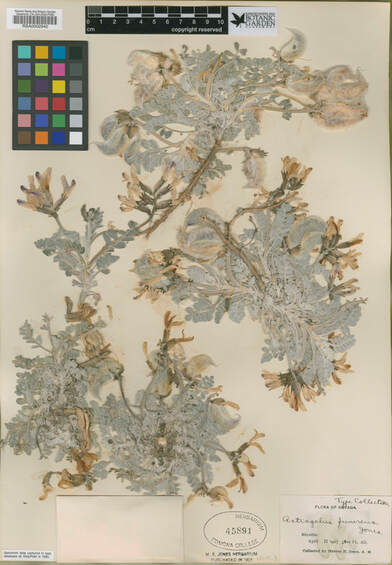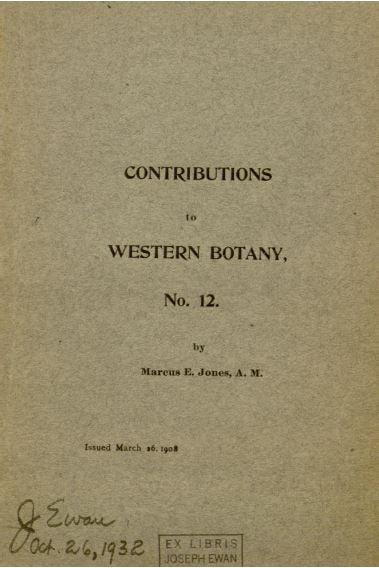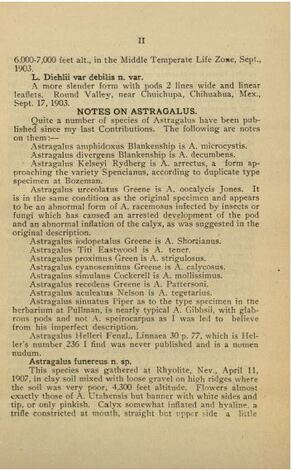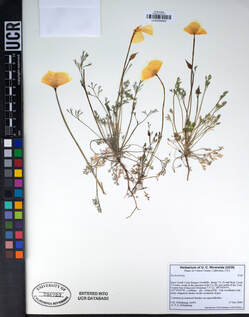What defines a poppy?
How do we know exactly which characteristics—size, leaf shape, number of hairs, etc.—constitute a member of a specific plant species?
This may seem like a philosophical question, but, for plant taxa, the answer is quite practical. When a botanist names a taxon—that is, they publish a description of the new species along with evidence for its separation from similar species—the botanist bases their description off of a type specimen. This specimen is the epitome of the species, the holy grail of that species' characteristics. In future work, scientists can refer back to this specimen to understand what characteristics are necessary for a plant to be assigned that particular taxonomic name.
There are over 34,000 type specimens represented in the CCH2 data portal (cch2.org). Not all of these represent different taxa; there are many kinds of types defined in the International Code of Nomenclature (an easy-to-read version in chapter 7 of this monograph), so there can be several types for one taxon. Below is the type specimen of black milkvetch (Astragalus funereus), an imperiled member of the pea family that is endemic to the Mojave desert. Rancho Santa Ana Botanic Garden houses this and many other type specimens in their collection, many of which are being digitized as part of the California Phenology Network,
How do we know exactly which characteristics—size, leaf shape, number of hairs, etc.—constitute a member of a specific plant species?
This may seem like a philosophical question, but, for plant taxa, the answer is quite practical. When a botanist names a taxon—that is, they publish a description of the new species along with evidence for its separation from similar species—the botanist bases their description off of a type specimen. This specimen is the epitome of the species, the holy grail of that species' characteristics. In future work, scientists can refer back to this specimen to understand what characteristics are necessary for a plant to be assigned that particular taxonomic name.
There are over 34,000 type specimens represented in the CCH2 data portal (cch2.org). Not all of these represent different taxa; there are many kinds of types defined in the International Code of Nomenclature (an easy-to-read version in chapter 7 of this monograph), so there can be several types for one taxon. Below is the type specimen of black milkvetch (Astragalus funereus), an imperiled member of the pea family that is endemic to the Mojave desert. Rancho Santa Ana Botanic Garden houses this and many other type specimens in their collection, many of which are being digitized as part of the California Phenology Network,
Did you catch the collection date? 1907! Like this one, many type specimens are quite old; however, new species are being described every year, bringing new type specimens into the fold.
The collector of this specimen is also the person who named the species, Marcus E. Jones. Jones published many plant names during his lifetime, and he is especially well-known for his work on milkvetch (Astragalus). His original description of Astragalus funereus was published in Contributions to Western Botany in 1908, only a year after the type specimen was collected.
The collector of this specimen is also the person who named the species, Marcus E. Jones. Jones published many plant names during his lifetime, and he is especially well-known for his work on milkvetch (Astragalus). His original description of Astragalus funereus was published in Contributions to Western Botany in 1908, only a year after the type specimen was collected.
(P.S. Did you know that hundreds, if not thousands, of original species descriptions can be viewed online through the Biodiversity Heritage Library? Check it out!)
Type specimens are incredibly valuable to science. Like original paintings by master artists, they serve as vital baselines for future work and verification of past work. Therefore, their preservation and study is a high priority for herbaria across the world. The California Phenology Network is proud to play a part in making type specimen data available for research and promoting protection of these important pieces of history.
Glossary
Further reading:
Hitchcock AS. 1921. The type concept in systematic botany. American Journal of Botany 8(5):251-255.
Type specimens are incredibly valuable to science. Like original paintings by master artists, they serve as vital baselines for future work and verification of past work. Therefore, their preservation and study is a high priority for herbaria across the world. The California Phenology Network is proud to play a part in making type specimen data available for research and promoting protection of these important pieces of history.
Glossary
- taxa - plural form of taxon, which is any named taxonomic group such as a genus, species, variety, or subspecies
- type specimen - the specimen that a botanist uses to formally name (i.e., publish to be recognized as a new taxon to science) a new taxon
Further reading:
Hitchcock AS. 1921. The type concept in systematic botany. American Journal of Botany 8(5):251-255.




